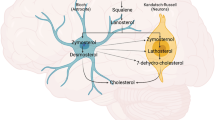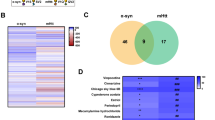Abstract
Our studies on the role of cholesterol in prion infection/replication showed that brains and peripheral cells of sheep susceptible-to or suffering-from Scrapie were characterized by an altered cholesterol homeostasis, and that drugs affecting cholesterol ester pool were endowed with selective anti-prion activity in N2a cell lines infected with the 22L and RML prion strains. In these prion-infected N2a cell lines, we now report increased anti-prion activity of dual-drug combinations consisting of cholesterol ester modulators associated with prion inhibitors. Synergism was obtained with the cholesterol ester modulators everolimus, pioglitazone, progesterone, and verapamil associated with the anti-prion chlorpromazine, and with everolimus and pioglitazone associated with the anti-prion quinacrine. In addition, comparative lipid analyses in prion-infected vs. uninfected N2a cells, demonstrated a derangement of type and distribution of cholesterol ester, free cholesterol, and triglyceride pools in the infected cells. Single-drug treatments differently affected synthesis of the various lipid forms, whereas combined drug treatments appeared to restore a lipid profile similar to that of the untreated-uninfected cells. We conclude that the anti-prion synergistic effects of cholesterol ester modulators associated with the cholesterol-interfering anti-prion drugs chlorpromazine and quinacrine may arise from the ability of combined drugs to re-establish lipid homeostasis in the prion-infected cells. Overall, these data suggest that inhibition of prion replication can be readily potentiated by combinatorial drug treatments and that steps of cholesterol/cholesterol ester metabolism may represent suitable targets.
Similar content being viewed by others
Abbreviations
- PrPres :
-
PK-resistant prion protein
- TL:
-
total lipids
- TC:
-
total cholesterol
- FC:
-
free cholesterol
- NL:
-
neutral lipids
- CE:
-
cholesterol esters
- TG:
-
triglycerides
- PL:
-
phospholipids
- DX 500:
-
dextran sulphate 500,000
- TA:
-
tannic acid
- CP:
-
chlorpromazine
- Q:
-
quinacrine
- EVE:
-
everolimus
- PIO:
-
pioglitazone
- PG:
-
progesterone
- VP:
-
verapamil
References
Prusiner S.B., Prions, Proc. Natl. Acad. Sci. USA, 1998, 95, 13363–13383
Trevitt C.R., Collinge J., A systematic review of prion therapeutics in experimental models, Brain, 2006, 129, 2241–2265
Doh-ura K., Ishikawa K., Murakami-Kubo I., Sasaki K., Mohri S., Race R., et al., Treatment of transmissible spongiform encephalopathy by intraventricular drug infusion in animal models, J. Virol., 2004, 78, 4999–5006
Bone I., Belton L., Walker A.S., Darbyshire J. Intraventricular pentosan polysulphate in human prion diseases: an observational study in the UK, Eur. J. Neurol., 2008, 15, 458–464
Love R., Old drugs to treat new variant Creutzfeldt-Jakob disease, Lancet, 2001, 358, 563–574
Stewart L.A., Rydzewska L.H.M., Keogh G.F., Knight R.S.G., Systematic review of therapeutic interventions in human prion disease, Neurology, 2008, 70, 1272–1281
Collinge J., Gorham M., Hudson F., Kennedy A., Keogh G., Pal S., et al., Safety and efficacy of quinacrine in human prion disease (PRION-1 study): a patient-preference trial, Lancet Neurol., 2009, 8, 334–344
Geschwind M.D., Clinical trials for prion disease: difficult challenges, but hope for the future, Lancet Neurol., 2009, 8, 304–306
CJD (Creutzfeldt-Jakob disease) quinacrine study. (accessed March 4, 2009). http://clinicaltrials.gov/ct2/show/NCT00183092
Kocisko D., Caughey B., Morrey J.D., Race R.E., Enhanced antiscrapie effect using combination drug treatment, Antimicrob. Agents Chemother., 2006, 50, 3447–3449
Pani A., Abete C., Norfo C., Mulas C., Putzolu M., Laconi S., et al., Cholesterol metabolism in brain and skin fibroblasts from Sarda breed sheep with scrapie resistant or susceptible genotype, Am. J. Infect. Dis., 2007, 3, 143–150
Pani A., Abete C., Norfo C., Mulas C., Putzolu M., Laconi S., et al., Accumulation of CE in ex vivo lymphocytes from scrapie-susceptible sheep and in scrapie-infected mouse neuroblastoma cell lines, Am. J. Infect. Dis., 2007, 3, 165–168
Orrù C.D., Abete C., Cannas M.D., Mulas C., Norfo C., Mandas A., et al., ACAT-1, Cav-1 and PrP expression in scrapie susceptible and resistant sheep, Cent. Eur. J. Biol., 2010, 5, 31–37
Pani A., Norfo C., Abete C., Mulas C., Putzolu M., Laconi S., et al., Anti-prion activity of cholesterol esterification modulators: a comparative study in ex vivo sheep fibroblasts and lymphocytes and in mouse neuroblastoma cell lines, Antimicrob. Agents Chemother., 2007, 51, 4141–4147
Doh-ura K., Iwaki T., Caughey B., Lysosomotropic Agents and Cysteine Protease Inhibitors Inhibit Scrapie-Associated Prion Protein Accumulation, J. Virol., 2000, 74, 4894–4897
Caughey B., Raymond G.J., Sulfated polyanion inhibition of scrapie-associated PrP accumulation in cultured cells, J. Virol., 1993, 67, 643–650
Caughey B., Brown K., Raymond G.J., Katzenstein G.E., Thresher W., Binding of the protease-sensitive form of PrP (prion protein) to sulfated glycosaminoglycan and congo red, J. Virol., 1994, 68, 2135–2141
Kocisko D.A., Engel A.L., Harbuck K., Arnold K.M., Olsen E.A., Raymond L.D., et al., Comparison of protease-resistant prion protein inhibitors in cell cultures infected with two strains of mouse and sheep scrapie, Neurosci. Lett., 2005, 388, 106–111
Suhnel J., Evaluation of synergism or antagonism for the combined action of antiviral agents, Antiv. Res., 1990, 13, 23–40
Pani A., Batetta B., Putzolu M., Sanna F., Spano O., Piras S., et al., MDR1, cholesterol esterification and cell growth: a comparative study in normal and multidrug-resistant KB cell lines, Cell. Mol. Life Sci., 2000, 57, 1094–1102
Greenspan P., Fowler S.D., Spectrofluorometric studies of the lipid probe, Nile red, J. Lipid Res., 1985, 26, 781–789
Diaz G., Batetta B., Sanna F., Uda S., Reali C., Angius F., et al., Lipid droplet changes in proliferating and quiescent 3T3 fibroblasts, Histochem. Cell Biol., 2008, 129, 611–621
Kocisko D.A., Baron G.S., Rubenstein R., Chen J., Kuizon S., Caughey B., New inhibitors of scrapie-associated prion protein formation in a library of 2000 drugs and natural products, J. Virol., 2003, 77, 10288–10296
Pani A., Dessì S., (Eds.), Cell Growth and Cholesterol Esters, New York: Landes Bioscence & Kluwer Academic Press Publishers, 2004
Batetta B., Mulas M.F., Sanna F., Putzolu M., Bonatesta R.R., Casperi-Campani A., et al., Role of cholesterol ester pathway in the control of cell cycle in human aortic smooth muscle cells, FASEB J., 2003, 17, 746–748
Varghese Z., Fernando R., Moorhead J.F., Powis S.H., Ruan X.Z., Effects of sirolimus on mesangial cell cholesterol homeostasis: a novel mechanism for its action against lipid-mediated injury in renal allografts, Am. J. Physiol. Renal Physiol., 2005, 289, 43–48
Freeman D.A., Romero A., Effects of troglitazone on intracellular cholesterol distribution and cholesterol-dependent cell functions in MA-10 Leydig tumor cells, Biochem. Pharmacol., 2003, 66, 307–313
Debry P., Nash E.A., Neklason D.W., Metherall J.E., Role of multidrug resistance P-glycoproteins in cholesterol esterification, J. Biol. Chem., 1997, 272, 1026–1031
Butler J.D., Banchette-Mackie J., Golden E., O’Neill R.R., Carstea G., Roff C.F., et al., Progesterone blocks cholesterol translocation from lysosomes, J. Biol. Chem., 1992, 267, 23797–23805
Barret A., Tagliavini F., Forloni G., Bate C., Salmona M., Colombo L., et al., Evaluation of quinacrine treatment for prion diseases, J. Virol., 2003, 77, 8462–8469
Klingenstein R., Lober S., Kujala P., Godsave S., Leliveld S.R., Gmeiner P., et al., Tricyclic antidepressants, quinacrine and a novel, synthetic chimera thereof clear prions by destabilizing detergent-resistant membrane compartments, J. Neurochem., 2006, 98, 748–759
FernØ J., Skrede S., O Vik-Mo A., Havic B., Steen V.D., Drug-induced activation of SREBP-controlled lipogenic gene expression in CNS-related cell lines: marked differences between various antipsychotic drugs, BMC Neuroscience, 2006, 7, 69–80
Vik-Mo A.O., Ferno J., Skrede S., Steen V.M., Psychotropic drugs up-regulate the expression of cholesterol transport proteins including ApoE in cultured human CNS- and liver cells, BMC Pharmacol., 2009, 9, 10
Kumar R., McClain D., Young R., Carlson G.A., Cholesterol transporter ATP-binding cassette A1 (ABCA1) is elevated in prion disease and affects PrPC and PrPSc concentrations in cultured cells, J. Gen. Virol., 2008, 89, 1525–1532
Bach C., Gilch S., Rost R., Greenwood A.D., Horsch M., Hajj G.N., et al., Prion-induced activation of cholesterogenic gene expression by Srebp2 in neuronal cells, J. Biol. Chem., 2009, 284, 31260–31269
Taylor D.R., Hooper N.M., Role of lipid rafts in the processing of the pathogenic prion and Alzheimer’s amyloid-β proteins, Sem. Cell. Develop. Biol., 2007, 18, 638–648
Bate C., Tayebi M., Williams A., Cholesterol esterification reduces the neurotoxicity of prions, Neuropharmacology, 2008, 54, 1247–1253
Ghaemmaghami S., Phuan P.W., Perkins B., Ullman J., May B.C., Cohen F.E., et al., Cell division modulates prion accumulation in cultured cells, Proc. Natl. Acad. Sci. USA., 2007, 104, 17971–17976
Author information
Authors and Affiliations
Corresponding author
Additional information
These authors contributed equally to this work.
About this article
Cite this article
Orrù, C.D., Cannas, M.D., Vascellari, S. et al. In vitro synergistic anti-prion effect of cholesterol ester modulators in combination with chlorpromazine and quinacrine. cent.eur.j.biol. 5, 151–165 (2010). https://doi.org/10.2478/s11535-009-0070-9
Received:
Accepted:
Published:
Issue Date:
DOI: https://doi.org/10.2478/s11535-009-0070-9




